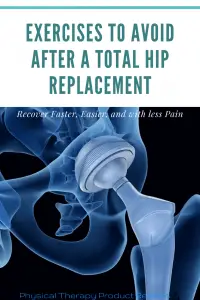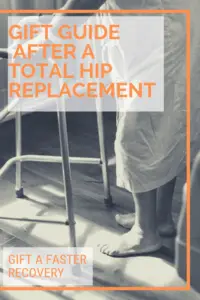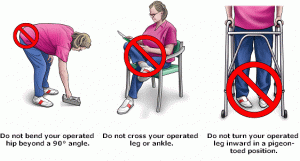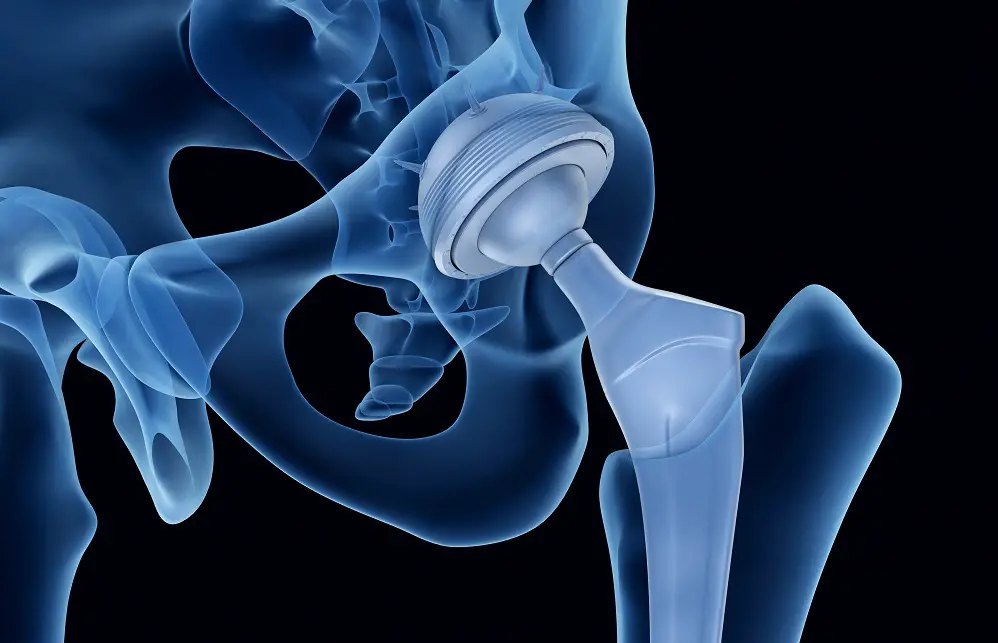 Total hip replacements are one of the most common surgeries in the United States with over 300,000 performed each year. As people live longer and modern medicine advances, more people are suffering from Osteoarthritis. Osteoarthritis is the wear and tear of a joint over time and is the cause for a total hip replacement. Once the hip joint is worn down, the body cannot currently make new cartilage or repair itelf. A total hip replacement can be a long and tiresome recovery. To better help navigate the long recovery here are the exercises and activities to avoid after a total hip replacement.
Total hip replacements are one of the most common surgeries in the United States with over 300,000 performed each year. As people live longer and modern medicine advances, more people are suffering from Osteoarthritis. Osteoarthritis is the wear and tear of a joint over time and is the cause for a total hip replacement. Once the hip joint is worn down, the body cannot currently make new cartilage or repair itelf. A total hip replacement can be a long and tiresome recovery. To better help navigate the long recovery here are the exercises and activities to avoid after a total hip replacement.
What is a Total Hip Replacement
A total hip replacement surgery involves re-surfacing both weight-bearing surfaces of the hip joint. As arthritis becomes so severe that the joint cartilage and joint space has worn down, it makes it difficult to walk, stand, or put weight into the hip. This bone on bone compression and rubbing of the two bones is extremely painful. There currently is no way to re-grow that cartilage to help cushion the joint again, so the current best practice is to undergo a hip replacement.
 Surgeons will replace the head of the hip with a metal alloy that is in a ball shape that mimics the natural head of the femur. The metal implant has a long end that is anchored in the middle of your Femur so help hold it in place. The Acetabulum is then resurfaced with a metal alloy “cup” that the head of the femur fits perfectly into and can rotate similar to a normal ball and socket joint.
Surgeons will replace the head of the hip with a metal alloy that is in a ball shape that mimics the natural head of the femur. The metal implant has a long end that is anchored in the middle of your Femur so help hold it in place. The Acetabulum is then resurfaced with a metal alloy “cup” that the head of the femur fits perfectly into and can rotate similar to a normal ball and socket joint.
How long is the Recovery for a Total Hip Replacement
You’ll see a variety of different answers when looking for a timeline of recovery after a total hip replacement and it all depends on how you want to classify recovery.
2 Weeks after Surgery:
The first two weeks are rough. The drugs are starting to taper off and the pain from cutting into the muscles and soft tissues are real. Mobility is limited and at this point, most people begin to questions if they should have had the surgery.
4 Weeks after Surgery:
At this point, you should be walking without a walker or assistive device and overall walking is almost normal. Pain at night is still normal and will present for a while. Putting on and taking off socks and shoes is still a struggle. Most people are beginning the be thankful that they have the surgery at this point or at least starting to see light at the end of the tunnel.
6 Weeks After Surgery:
Most people feel pretty good at this point. You are looking to be between 50-65% of normal at this point. Most of the bone trauma has begun healing. Also important is that the post-surgical precautions for a posterior approach become more of guidelines at this time. Most people still have pain at night and also have difficulty hiking or going down steep hills.
3 Months After Surgery:
The pain at night is almost nearly gone and the dull ache is forgotten for most of the day. You should feel pretty good at this point, maybe 75-80% of normal. Most of the soft tissue trauma from surgery has healed and you forget that you even limped after surgery. The biggest limitation at this point is strength, especially if you wanted too long to have the surgery and the muscles become weak from protecting it.
1 Year After Surgery:
Congrats! This is close to the new normal for the hip. It truly takes 1 year to officially know what you got after the surgery. Some people will be better than they expected and some of the high-level athletes will be disappointed because it’s never going to be better than the original hip in its prime. The pain should be gone by now and most of the strength should be back to normal if you kept up with the exercises. You may have already started planning to have the other hip done because you feel so much better
Now that you know more about how long it takes to heal, let’s look at some of the exercises to avoid after surgery to help you heal faster and get back to doing the things that you love.
Did a friend or family recently have a total hip replacement? Check out the best gifts after a total hip replacement to speed up recovery and improve pain. 
What Exercises to Avoid After Total Hip Surgery
STOP – Straight Leg Raises (SLR)
This is a big one, even though this looks like a fairly harmless exercise. The length and weight of the leg are simply too much for a brand new hip. Plus, all of the muscles that you perform this exercise with were either stretched like crazy during surgery or will pull on the hip capsule that has stitches and is trying to heal. There are other ways you can can work the same muscles that is not harmful. Instead we recommend doing the exercise in standing. Feel free to start doing this on your back after 6 weeks of recovery if it is pain-free and there is no soreness afterwards.
STOP – Exercises That Break Posterior Hip Precautions
 If your surgeon performed a posterior approach total hip replacement then for the first 6 weeks after surgery (and some may say longer) you are not allowed to break precautions. This is actually harder than it sounds. You need to avoid the combination of these movements:
If your surgeon performed a posterior approach total hip replacement then for the first 6 weeks after surgery (and some may say longer) you are not allowed to break precautions. This is actually harder than it sounds. You need to avoid the combination of these movements:
- Hip Adduction
- Hip Flexion
- Hip Internal Rotation
So no stretching the side of the glute/hip, no bringing your knees up to your chest and especially difficult to remember but don’t turn your foot out and your knee into the midline. We usually recommend using a hip adduction pillow when sleeping to help keep your precations.
STOP – Bending into Flexion Such as…..Putting on your Shoes/Tying Shoes
This may seem like a harmless movement but as anyone who has already had a hip replacement can attest to it is tough to put your own socks and shoes on. This is all about your hip precautions. Most people will bend forward to put on their shoes and break the hip flexion precautions or will try and turn their foot out to get them on. These are both a no-no. The safest way is to use a sock aid or to try and slide your surgical foot slowly up the good leg. This however usually takes around 6 weeks to be able to do.
STOP – Sitting Too Long and Sitting on a Low Surface
This one isn’t as obvious but this is all about healing faster. Sitting is good in short bouts to allow the muscles to rest and heal. HOWEVER, too much sitting causes things to tighten and stiffen up. The hip has poor blood supply so it relies on movement and muscles to pump blood into the joint space.  The more blood the area has, the faster it is going to heal, and the less stiff it will feel. Try to put a timer on your phone to move every 45 minutes and even though the lazy boy recliners are comfortable, they can be hard to get out of.
The more blood the area has, the faster it is going to heal, and the less stiff it will feel. Try to put a timer on your phone to move every 45 minutes and even though the lazy boy recliners are comfortable, they can be hard to get out of.
Also, if you are trying to sit in a chair that is too low it will be 1) hard to get out of and cause undue strain but 2) you will break hip precaution by having hip flexion greater than 90 degrees. If the chair is too low you may need to add a cushion to increase the height and to stay within your precautions. The Care Apparel seat riser has excellent reviews online and is personally recommended by our patients.
Picking Up Something From the Floor
Again, another benign movement but I’ve personally had two people dislocate with this simple motion. Once again, it breaks hip flexion precautions. One person was trying to start their lawnmower and the other person was bending down to grab the remote control off the floor. To help with this we recommend using a reacher or grabber and to have someone stay with you in the early recovery to help with easy things such as this.
Running/Jumping/Heavy Lifting
Finally a simple one right? Well, you would be surprised. It never fails that someone tries to run, jump, or return to the gym before they should and sets themselves back. The mindset is often “I have a new hip so it’s good to go right?” This can even happen in unexpected circumstances such as going up or down a curb and you do a little hop down. Just be aware and wait for everything to heal. Always ask your surgeon or physical therapist at what point you can safely start running if at all. We like to wait until after 3 months at the earliest.
Conclusion
A Total Hip Replacement can be a scary surgery to have and as with anything that is new, you can feel lost on what to do. Now that you know what exercises and activities to avoid you can make sure that your progress is heading in the right direction. Feel free to reach out with any questions in the comment or contact us section.
Works Referenced
https://www.ncbi.nlm.nih.gov/pmc/articles/PMC4551172/
https://www.sciencedirect.com/science/article/pii/S0140673617300594
https://ard.bmj.com/content/annrheumdis/74/1/164.full.pdf
Picture credits:
https://orthoinfo.aaos.org/en/treatment/total-hip-replacement/
http://thomasbondphysio.blogspot.com/2012/12/surgery-to-hip.html
https://myhealth.alberta.ca/Health/aftercareinformation/pages/conditions.aspx?hwid=ug3861
Total Hip Arthroplasty Revision Rate Examined From 2007 to 2013
Disclaimer: The information provided in this post is for educational purposes only. This is not a substitute for a medical appointment. Please refer to your physician before starting any exercise program.


Comments are closed.